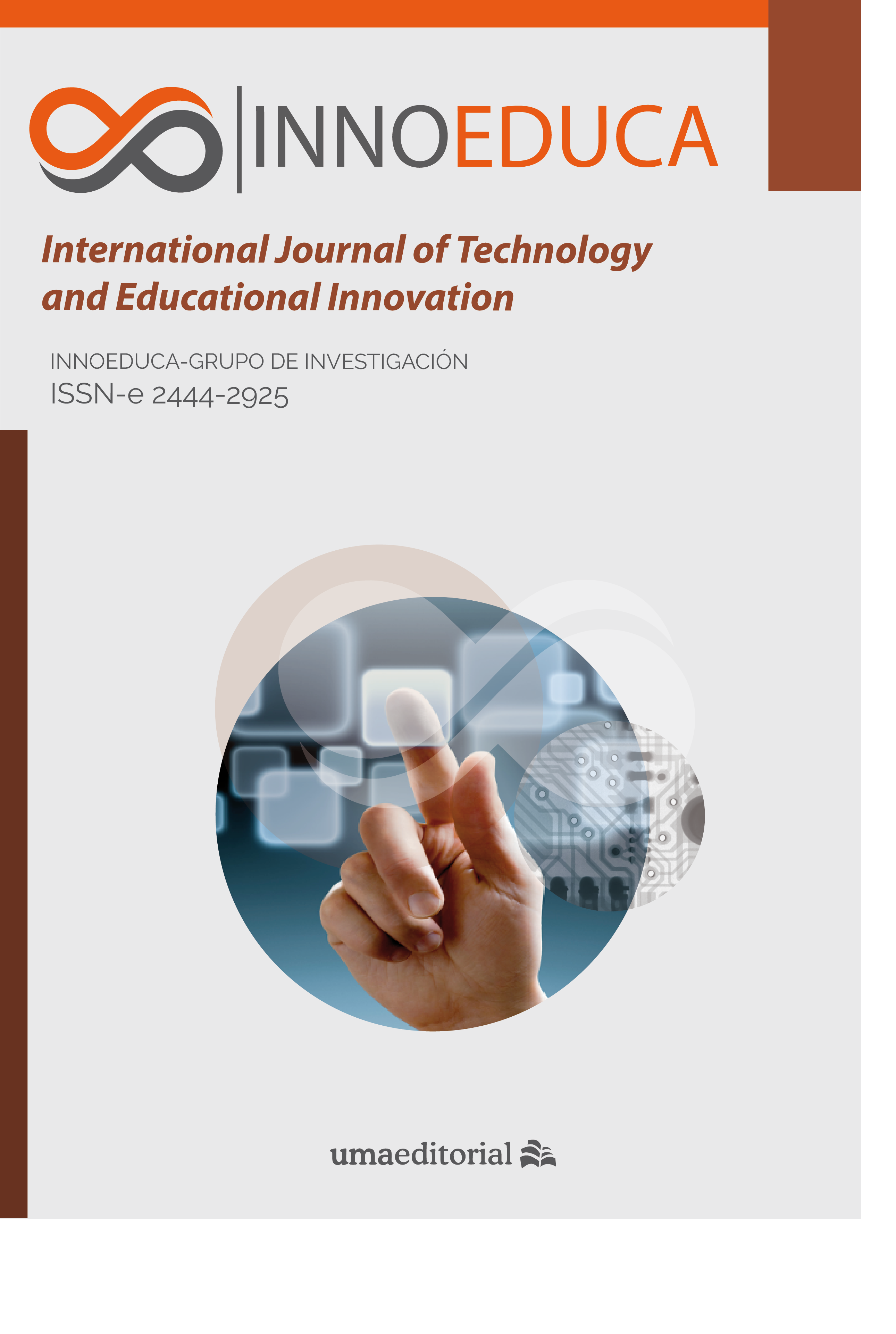La realidad de la brecha de conectividad en el ámbito educativo español: Análisis de la situación actual.
DOI:
https://doi.org/10.24310/innoeduca.2020.v6i1.7741Resumen
El acceso a Internet se ha convertido en una herramienta indispensable en la sociedad en la que vivimos, y por consiguiente, las escuelas no han permanecido ajenas a este fenómeno. Su uso se ha convertido en una acción indispensable en el quehacer diario de una institución educativa.
Con este estudio se pretende analizar el estado actual de la conectividad del sistema educativo español, y determinar la brecha de conectividad existente entre las diferentes comunidades de España.
Se ha podido observar que, desde una perspectiva general, a diferencia de las creencias del profesorado y alumnado de los distintos centros educativos, la conectividad goza de un estado de salud óptimo, con un porcentaje medio de disponibilidad de conexión en las aulas superior al 90%. Sin embargo, no todas las Comunidades Autónomas gozan de la misma calidad de conexión, habiendo diferencias significativas dependiendo de la región en la que se ponga el foco. Esto supone un hándicap en el desarrollo de una secuencia didáctica mediada por tecnología en un aula.
Descargas
Métricas
Publicación Facts
Perfil de revisores N/D
Información adicional autores
Indexado: {$indexList}
-
Indexado en
- Sociedad Académica/Grupo
- N/D
- Editora:
- Universidad de Málaga
Citas
Alexander, B., Ashford-Rowe, K., Barajas-Murphy, N., Dobbin, G., Knott, J., McCormack, M., Pomerantz, J., Seilhamer, R., y Weber, N. (2019). Educause Horizon Report. 2019 Higher Education Edition. Louisville: Co: Educause.
Barrera-Osorio, F., y Linden, L. L. (2009). The use and misuse of computers in education: evidence from a randomized experiment in Colombia (Policy Research Working Paper, 4836). Washington DC: World Bank.
Barrett, P., Davies, F., Zhang, Y., y Barrett, L. (2017). The Holistic Impact of Classroom Spaces on Learning in Specific Subjects. Environment and Behavior, 49(4), 425-451. https://doi.org/10.1177/0013916516648735
Brown, J., Ortiz-Padilla, M., y Soto-Varela, R. (2020). Does Mathematical Anxiety Differ Cross-Culturally? Journal of New Approaches in Educational Research, 9(1), 126-136. doi:http://dx.doi.org/10.7821/naer.2020.1.464
Cabero, J. (2015). Inclusio?n digital – inclusio?n educativa. Sinergia, 2, 15–18. Recuperado de http://telebachilleratoenchiapas.gob.mx/wpcontent/uploads/2015/08/SINERGIA2Edicio?n.pdf.
Cabero, J., Mari?n, V., y Llorente, M.C. (2012). Desarrollar la competencia digital. Educacio?n media?tica a lo largo de toda la vida. Sevilla: Eduforma.
Cabero Almenara, J., y Ruiz Palmero, J. (2017). Las Tecnologías de la Información y Comunicación para la inclusión: reformulando la brecha digital. International Journal of Educational Research and Innovation, 9, 16-30.
Escofet, A., Gros, B., López, M. y Marimon-Martí, M. (2019). Percepción del profesorado sobre la integración de la tecnología en el espacio escolar. RIITE. Revista Interuniversitaria de Investigación en Tecnología Educativa, 6, 37-47. Doi: http://dx.doi.org/10.6018/riite.360631
European Commission (2008). The education and training contribution to the Lisbon strategy. Recuperado de http://ec.europa.eu/education/policies/2010/et_2010_en.html.
Facebook and The Economist Intelligence Unit (2019). The Inclusive Internet Index 2019. Recuperado de https://theinclusiveinternet.eiu.com
Fundación Telefónica (2019). Sociedad Digital en España 2018. Barcelona: Penguin Random House Grupo Editorial.
Gómez García, M., Ruiz Palmero, J., y Sánchez Rodríguez, J. (2015). Aprendizaje social en red. Las redes digitales en la formación universitaria. EDMETIC, 4(2), 71-87. doi:https://doi.org/10.21071/edmetic.v4i2.3963
James, J. (2011). Are Changes in the Digital Divide Consistent with Global Equality or Inequality? The Information Society, 27, 121–128. doi: 10.1080/01972243.2011.548705.
Law, N., Pelgrum, W.J., y Plomo, T. (Eds.) (2008). Pedagogy and ICT in schools around the world: findings from the SITES 2006 study. Hong Kong: CERC and Springer.
Long, P. D., y Ehrmann, S. C. (2005). Future of the learning space: Breaking out of the box. EDUCAUSE review, 40(4), 42-58.
Ministerio de Educación Cultura y Deporte (MECD). (2018a). Estadística de las Enseñanzas no universitarias. Resultados Detallados, Metodología. Curso 2016-2017. Recuperado de http://www.educacionyfp.gob.es/dam/jcr:122f2c8c-26d1-409f-ad8d-170bf908f8a0/metnouni1617.pdf
Ministerio de Educación Cultura y Deporte (MECD). (2018b). Tablas y Figuras. Estadística de las Enseñanzas no universitarias. Resultados Detallados. Curso 2016-2017. Recuperado de https://www.educacionyfp.gob.es/servicios-al-ciudadano/estadisticas/no-universitaria/centros/sociedad-informacion.html
Morozov, E. (2015). La locura del solucionismo tecnolo?gico. Madrid: Clave Intelectual.
OECD (2019). How´s Life in the Digital Age? Opportunities and Risks of the Digital Transformation for People´s Well-being. OECD Publishing, Paris, https://doi.org/10.1787/9789264311800-en.
Orozco, G. (2015). Lo televisivo como escenario de las transformaciones entre TV y audiencias. En G. Orozco, G. (coord.), Tvmorforsis 4. Television everywhere (pp. 77-83). Me?xico: Productora de contenidos culturales Sagaho?n Repoll.
Ríos, M. (2018). Negroponte: The Man Who Would Change the World, But Everything Went Wrong. Recuperado de https://ssrn.com/abstract=3170428 http://dx.doi.org/10.2139/ssrn.3170428
Ruiz-Palmero, J., Sánchez Rodríguez, J., y Gómez García, M. (2013). Entornos personales de aprendizaje: estado de la situación en la Facultad de Ciencias de la Educación de la Universidad de Málaga. Píxel-Bit. Revista de Medios y Educación.
Segura, M.P., Solano, I.M. y Sánchez, M.M. (2018). Uso didáctico de las TIC en los colegios rurales agrupados de la Región de Murcia. RIITE. Revista Interuniversitaria de Investigación en Tecnología Educativa, 5, 102-115. Doi: http://dx.doi.org/10.6018/riite/2018/343771
UNESCO (2019). Unesco´s Internet Universality indicators. Recuperado de https://unesdoc.unesco.org/ark:/48223/pf0000265830
Publicado
Cómo citar
Número
Sección
Licencia
Todos los contenidos publicados por Innoeduca. International Journal of Technology and Educational Innovation están sujetos a la licencia de Creative Commons Reconocimiento-No comercial- SinObraDerivada 4.0 Internacional, cuyo texto completo se puede consultar en https://creativecommons.org/licenses/by-nc-nd/4.0/legalcode. Por lo tanto, la copia, distribución, comunicación pública, obras derivadas y el uso comercial de los contenidos están permitidas siempre que la fuente y el autor del texto se citen.
Es responsabilidad de los autores obtener los permisos necesarios de las imágenes que están sujetas a derechos de autor.

Este obra está bajo una licencia de Creative Commons Reconocimiento-NoComercial-SinObraDerivada 4.0 Internacional.













241.png)







